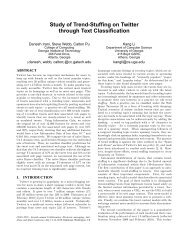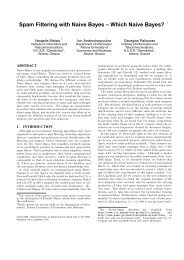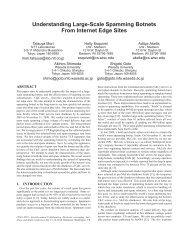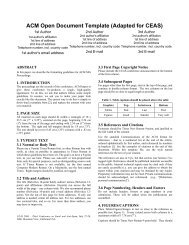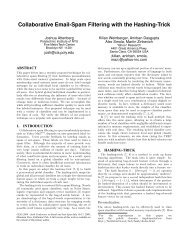CallRank: Combating SPIT Using Call Duration, Social Networks ...
CallRank: Combating SPIT Using Call Duration, Social Networks ...
CallRank: Combating SPIT Using Call Duration, Social Networks ...
You also want an ePaper? Increase the reach of your titles
YUMPU automatically turns print PDFs into web optimized ePapers that Google loves.
Proxies that provide billing services maintain call durationinformation for all users within their domain. The proxy is,therefore, the best place to maintain and update the reputationmatrix. Periodically it can calculate and update theleading eigenvector of the matrix. In addition the proxycan also include users (from other domains) who have eithermade or received calls to or from this domain in its reputationmatrix. In <strong><strong>Call</strong>Rank</strong>, when a proxy server receives acall request it consults the eigenvector calculated to obtainthe reputation value for the caller and appends this informationto the request. This reputation information can be sentsecurely to the call recipient as this only requires a securepath between the call recipient and his proxy (within a domainwe can hope to use strong security mechanisms). Thecall recipient can then decide based on a threshold value ifthe calls will be accepted. Ensuring that only the call recipient’sproxy appends a reputation value thwarts the attackthat spammers can employ - creating their own proxy andproviding high reputation values for their spam calls.3.3.1 Evaluating Threats to Global Reputation SchemeWe discussed how it is hard for a spammer to penetratea legitimate user’s SN and thus compromise <strong><strong>Call</strong>Rank</strong>’s effectiveness.It is equally hard for the spammer to obtain ahigh global reputation value. This is because the reputationvalue is based on call interactions with a number of usersand takes into account the reputation of these users. If aspammer needs to have a high reputation value, he will needa significant number of moderately reputed users to call himand speak for significantly long durations. This is unlikelyto occur. A legitimate user, on the other hand, will havea high reputation value due to call interactions with otherlegitimate users (a feedback loop). This implies that <strong>Call</strong>-Rank can counter attacks where new identities are createdeach time the old ones are flagged as malicious (as done ina Blacklist). This is because the new identities are only acceptedas legitimate when they can provide SN credentialsor garner significant reputation values.In the case of Sybil attacks[5], where a small number of entitiescounterfeit multiple identities to compromise the systemwe note that <strong><strong>Call</strong>Rank</strong> is fairly resistant. If the entitiesthemselves have weak SN linkages or low reputation values,then creating new identities will not help at all. If the entities,however, have strong SN linkages or high reputationvalues, then the identities they create can be made reputableor provided with these linkages. In such a scenario the systemwill soon realize that credentials coming from this setof entities lead to spam calls following which the reputationof the entities and the identities they have created beginto drop, therefore affecting their ability to continue makingspam calls.3.4 The Introduction ProblemWhen a new legitimate user joins a VoIP system he hasno SN linkages in that system and a low reputation value.This will change if other users call him, thereby increasinghis reputation value and providing him with call credentials.However, other users are unaware of his entry into the VoIPsystem. In order to notify other users he will need to makethe first call. In <strong><strong>Call</strong>Rank</strong>, however, all calls he makes willbe flagged as spam calls, which amounts to a false positive.We can fix this by combining <strong><strong>Call</strong>Rank</strong> with other schemesproposed for VoIP spam such as an audio Turing test or acomputational puzzle. When a user is flagged as a spammerhe will then be subject to the Turing test or a computationalpuzzle or even a personalized question from the call recipient(what is my high school nickname). The call is accepted ifthe caller is able to successfully answer any of these tests.In our simulation we have not included such a Turing testand this forms part of our future work.3.5 <strong>Call</strong> CredentialsThe call credential needs to have accurate and secure informationabout the call durations. A call credential CCconsists of A, the identity of the caller, B, the identity of thecall recipient, t, the call duration and TS, the time stampof the call along with a digital signature of the same information.We assume that each user has a public/private keypair which is used to generate the digital signature. If notalready available, this pair can be generated by the UA onfirst use. Associating a public key with a particular user isdone with key rings in the manner proposed in [11], thusavoiding the use of an infrastructure such as the PKI.The accuracy of the information within the credential canbe verified by the proxy which also records call duration information.We assume the proxy has an accurate value ofcall duration as it provides billing services. Therefore, theproxy does not need call credentials for calculating reputationvalues. In fact, if the proxy is used to determine the SNlinkage for a call, we do not need call credentials. However,we believe moving the SN linkage detection to the proxymakes the system unscalable.To understand the call credential better, we consider whatit means from a human perspective. This credential is arecord of the user’s past observed behavior in the systemor his call history. If the user is an active member of aparticular VoIP community, making and receiving calls, hewill accumulate the community relevant credentials throughhis interactions, making it easier to identify him accuratelywithin the community. If for some reason there is a sufficientlylong break from the community then when he reenters,he will once again have to reestablish himself. Thisis how it works in the real world. Since credential collectioncan be done by the user’s phone without any input from theuser there is minimal impact on usability. <strong>Using</strong> call durationas a building block has the following advantages. It is(i) implicit, (ii) quantifiable (iii) easily verifiable, and (iv)easily understood.3.6 Discussion of <strong><strong>Call</strong>Rank</strong> AlgorithmTo summarize, the <strong><strong>Call</strong>Rank</strong> algorithm works as follows.On receipt of a call setup message, the UA first checks to seeif any call credentials presented by the caller belong to usersto whom the UA has made calls. If such a credential is foundand it satisfies the policy duration and freshness constraints,the call is accepted. If no credential satisfies the constraintsthen the algorithm checks the reputation value of the caller.If this satisfies a particular acceptable reputation threshold,then the call is accepted else it is rejected. Rather thanrejecting the call the caller can be made to go through aTuring test or a call recipient specific computational puzzle.However we propose to explore this in future work.Integrating the <strong><strong>Call</strong>Rank</strong> algorithm into SIP will requirethat the initial INV ITE message also carry call credentialsas well as proxy appended reputation scores. Clients that donot implement the <strong><strong>Call</strong>Rank</strong> algorithm can simply choose to
ignore this information.<strong><strong>Call</strong>Rank</strong> does have some limitations. The first limitationis that legitimate users, who make a large number of outgoingcalls but receive very few incoming ones, would not beable to collect call credentials. Typical examples are emergencyservices and banks. Since these systems are part ofcritical infrastructure, they can be seeded with high globalreputation values. The second concern is one of privacy asthe collection of call credentials provides a user with thecall history information of their immediate SN. We plan toaddress this limitation as part of future work.Fraction of spam calls accepted0.250.20.150.10.05False Negatives1% spammer10% spammer20% spammer4. CALLRANK EVALUATIONAn evaluation of <strong><strong>Call</strong>Rank</strong> in the real world would requirecall logs from a VoIP system along with actual casesof VoIP spam. <strong>Call</strong> logs are hard to come by due to privacyconcerns and VoIP spam is still not widespread enough. Instead,we simulate <strong><strong>Call</strong>Rank</strong> with a synthetic call workloadto evaluate its effectiveness, ensuring that the simulationsmodel real world call characteristics as closely as possible.In particular, we measure how <strong><strong>Call</strong>Rank</strong> can be used to distinguishbetween legitimate callers and spammers and theresults are discussed in Sections 4.1, 4.2 and 4.3. We studythe acceptance of a legitimate caller into the <strong><strong>Call</strong>Rank</strong> systemin Section 4.4.Our initial experimental setup consists of DNS, proxy andstatistics servers and user agents (phones). Initially, onlythe DNS and the statistics server are running. Each proxyserver registers with the DNS server, and the user agents(UAs) register with the proxy. UAs either behave as reputedusers (seeded with high reputation values), legitimate users(users who make legitimate calls but are not seeded withhigh reputation values), or as spammers. A legitimate ora reputed UA makes calls to other phones with inter calland call duration values that are Poisson distributed. Thechoice of call recipient is Zipfian distributed. SpammingUAs, however, make calls to as many other UAs as possible.<strong>Call</strong> setup goes through the proxies which consult theDNS server and then route the call to the proxy in the callrecipient’s domain, which in turn forwards the call to thecall recipient. During the learning period (which can beset), a call recipient will accept all calls. After the learningperiod, a call is accepted or rejected based on the workingof <strong><strong>Call</strong>Rank</strong>. All call interactions are recorded at thestatistics server which tracks the number of accepted andrejected calls for both legitimate users and spammers. Ourinitial setup consists of three domains each served by a proxyserver and 200 users initially registered in each domain. 1%of the 600 users are reputed. The number of spammers andregular users is varied based on the experiment. We use asimulated call workload model. To simulate call processingfor a sufficient period of time, 100 seconds of machine timemodels 1 day of simulated time.4.1 Effect of SpammersThe first set of experiments determines the effect of spammerson <strong><strong>Call</strong>Rank</strong>. Three runs are conducted where thespammers present are varied from 1%, 10% and 20% andthe fraction of spam calls accepted for each case is measured.The results are as shown in Figure 4 which plots the fractionof spam calls accepted with time. When legitimate usersjoin the system they have a learning period during whichthey accept ALL calls. This period is essential for the user00 1 2 3 4 5Simulated Time (day)Figure 4: Effect of spammersto gather credentials and build reputation. However, duringthis period, they are vulnerable to spam calls. The spammerthus needs to detect a new user within the learning periodtime window and then send all the spam they can generate.In our simulation the learning period for all UAs is fixed at1 day. All 3 lines initially show increase as spammers learnabout more and more legitimate users and are able to sendspam to them successfully. This increase lasts roughly forthe learning period and then starts decreasing rapidly. Thisis because legitimate users, using the <strong><strong>Call</strong>Rank</strong> scheme, areable to differentiate between spammers and legitimate userssoon after their learning periods. For all 3 lines there are nonew spam calls accepted after 4.5 days.As the percentage of spammers increases from 1% to 10%and then to 20%, the probability of some spammer discoveringa legitimate user increases and the ability to send largeramounts of spam increases as well. This is seen in Figure4 as each of the curves shows higher false negative rates of1%, 10% and 22% respectively. Thus, the false positive rateincreases linearly with the number of spammers. However,these numbers are contingent on the fact that legitimateusers are discovered by spammers within their short learningperiod time window. If the legitimate user is undiscoveredthen the rates will drop down even further. In fact, oncea legitimate user crosses his learning period, he is able toidentify spammers (old and new) with ease.4.2 Addition of New SpammersWe start with an initial population of 600 UAs, 1% ofwhich are reputed UAs, 10% spammer UAs and the rest arelegitimate UAs. We wait until the system stabilizes, that isno new spam calls are accepted or no new legitimate callsare rejected. From Figure 5 we see this occurs after 2 daysand the number of accepted spam calls has saturated around1000 calls. We then add spammers, 1%, 10% and then 20%of the current UA population. As seen, the addition of thesespammers does not increase the number of accepted spamcalls illustrating that <strong><strong>Call</strong>Rank</strong>’s mechanisms ensure thatnew spammers do not affect existing legitimate users. Thereason behind this is that a new spammer, when introduced,does not have any SN linkage or reputation. Therefore, existinglegitimate users will not accept any calls originatingfrom them. Thereafter a spammer, due to his behavior, willnot improve either his SN or reputation implying that at nostage will a legitimate user accept a call from him. This is
addition, our system is able to accept new legitimate usersrelatively easily while ensuring that new spammers are notable to affect existing users. In the future we plan to exploremechanisms that maintain privacy of users by creating aggregatecall credentials for a group of users.6. ACKNOWLEDGMENTSWe would like to thank Deepak Manohar, Chris Rouland,Tom Cross, Dr. Nathaniel Borenstein and the GTISC VoIPSecurity team for valuable discussions. We would also liketo thank the anonymous reviewers of CEAS for the valuablereview comments provided.7. REFERENCES[1] J. A. Barnes. Graph theory and social networks: Atechnical comment on connectedness and connectivity.Sociology, 3(2), 1969.[2] P. Boykin and V. Roychowdhury. Leveraging socialnetworks to fight spam. IEEE Computer, 38(4):61–68,2005.[3] P.-A. Chirita, J. Diederich, and W. Nejdl. Mailrank:using ranking for spam detection. In O. Herzog, H.-J.Schek, N. Fuhr, A. Chowdhury, and W. Teiken,editors, CIKM, pages 373–380. ACM, 2005.[4] R. Dantu and P. Kolan. Detecting Spam in VoIP<strong>Networks</strong>. In Proceedings of the Steps to ReducingUnwanted Traffic on the Internet Workshop, pages31–37, Cambridge, MA, July 2005.[5] J. R. Douceur. The sybil attack. In IPTPS ’01:Revised Papers from the First International Workshopon Peer-to-Peer Systems, pages 251–260, London, UK,2002. Springer-Verlag.[6] G. H. Golub and C. F. Van Loan. MatrixComputations (Johns Hopkins Studies inMathematical Sciences). The Johns HopkinsUniversity Press, October 1996.[7] M. Hansen, M. Hansen, J. Mller, T. Rohwer,C. Tolkmit, and H. Waack. Developing a legallycompliant reachability management system as acountermeasure against spit. In Proceedings of ThirdAnnual VoIP Security Workshop, Berlin, Germany,Jun 2006.[8] T. Hansen, D. Crocker, and P. Hallam-Baker.Domainkeys identified mail (dkim) message signingservice overview, Mar 2007. IETF-DRAFTdraft-ietf-dkim-overview-04.txt.[9] C. Jennings, J. Peterson, and M. Watson. Privateextensions to the session initiation protocol (sip) forasserted identity within trusted networks, 2002.[10] S. D. Kamvar, M. T. Schlosser, and H. Garcia-Molina.The eigentrust algorithm for reputation managementin p2p networks. In Proc. 12th International WorldWide Web Conference, Budapest, Hungary, May 2003.[11] L. Kong, V. A. Balasubramaniyan, and M. Ahamad.A lightweight scheme for securely and reliably locatingsip users. In 1st IEEE Workshop on VoIPManagement and Security, Vancouver, Canada, Apr2006.[12] Y. Rebahi and D. Sisalem. Sip service providers andthe spam problem. In 2nd Workshop on SecuringVoice over IP, Washington DC, USA, Jun 2005.[13] J. Rosenberg and C. Jennings. The session initiationprotocol (sip) and spam, Feb 2007. IETF-DRAFTdraft-ietf-sipping-spam-04.txt.[14] J. Rosenberg, H. Schulzrinne, G. Camarillo,A. Johnston, J. Peterson, R. Sparks, M. Handley, andE. Schooler. Sip: Session initiation protocol, Jun 2002.RFC 3261.[15] R. Shaw. Four reasons why vonage ipos email andphone pitch is the wrong strategy. ZDNet, 2006.[16] D. Shin and C. Shim. Voice spam control with grayleveling. In 2nd Workshop on Securing Voice over IP,Washington DC, USA, Jun 2005.[17] B. Sterman. A security model for spit prevention. In2nd Workshop on Securing Voice over IP, WashingtonDC, USA, Jun 2005.[18] G. A. Thom. H.323: the multimedia communicationsstandard for local area networks. CommunicationsMagazine, IEEE, 34(12):52–56, 1996.[19] H. Tschofenig, J. Peterson, J. Polk, D. Sicker, andM. Tegnander. <strong>Using</strong> saml for sip, Jul 2005.IETF-DRAFT draft-tschofenig-sip-saml-04.txt.[20] VoDaSec. Spitting over the internet.http://www.vodasec.com/.[21] D. J. Watts and S. H. Strogatz. Collective dynamics of’small-world’ networks. Nature, 393:440–442, April1998.




